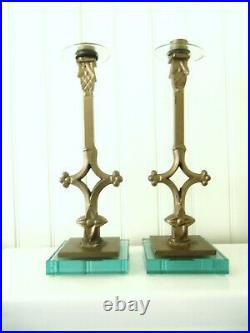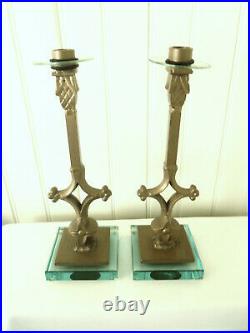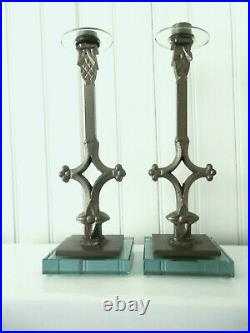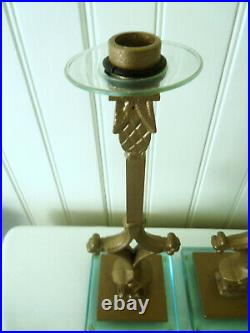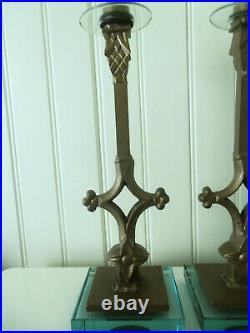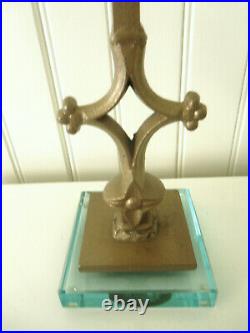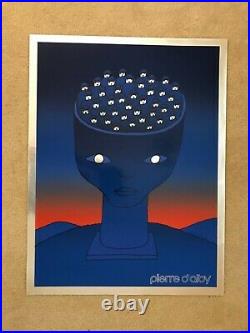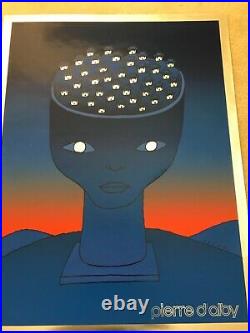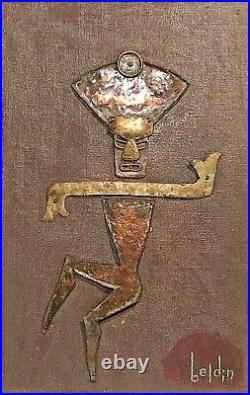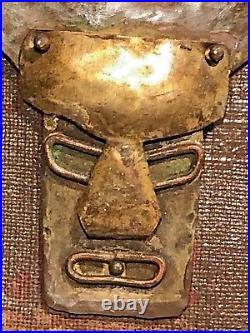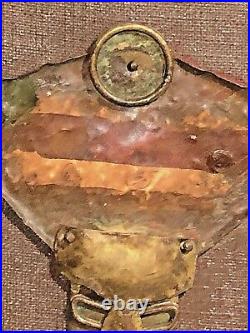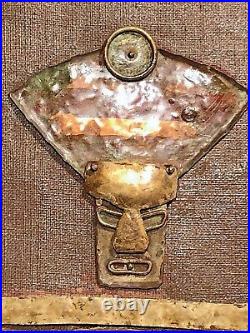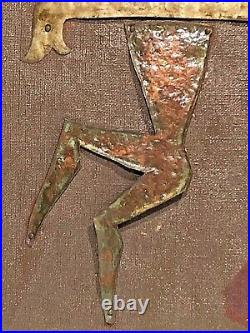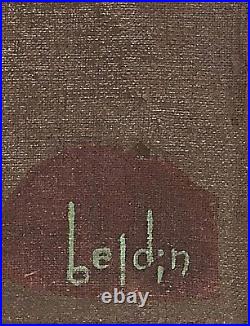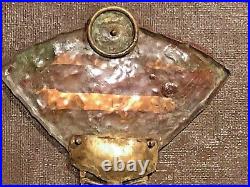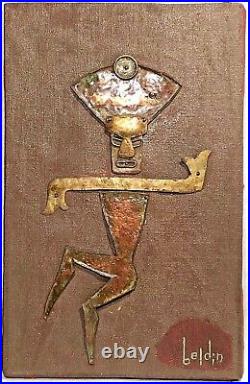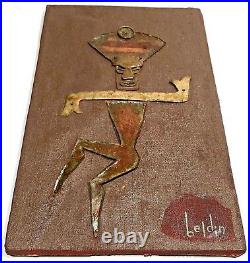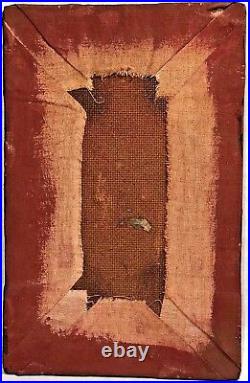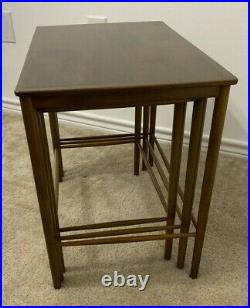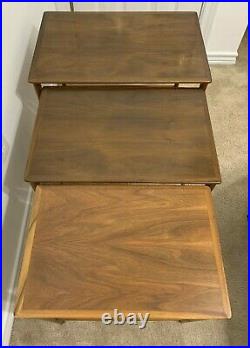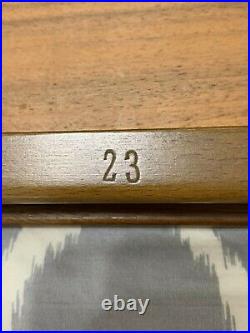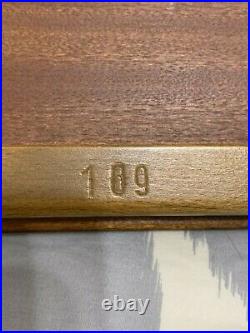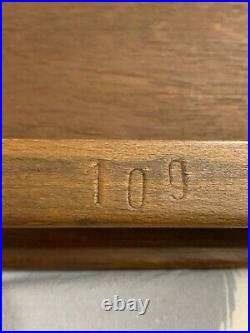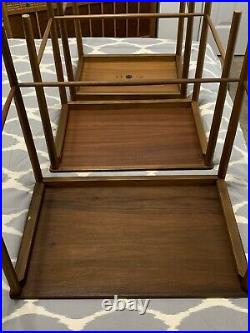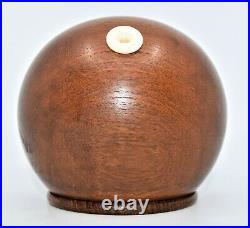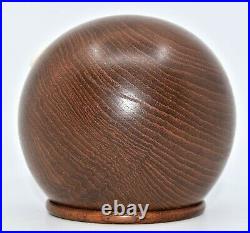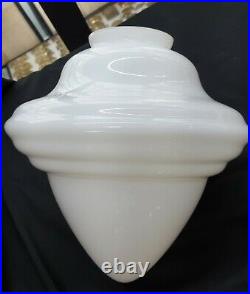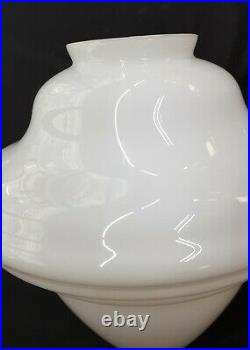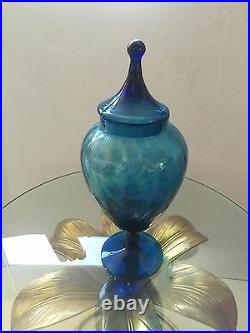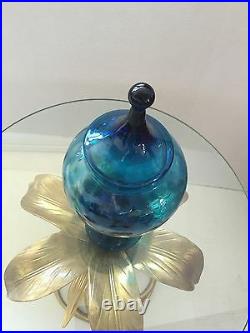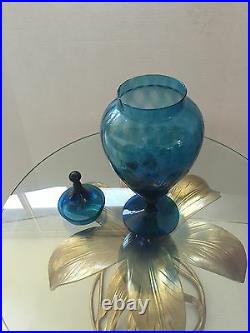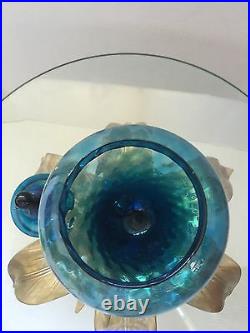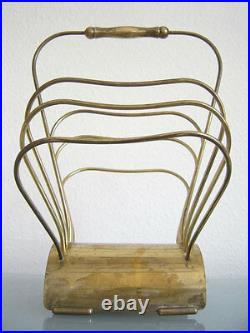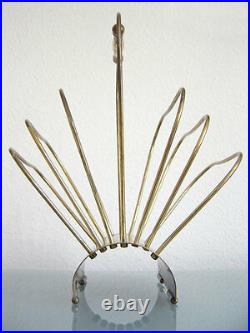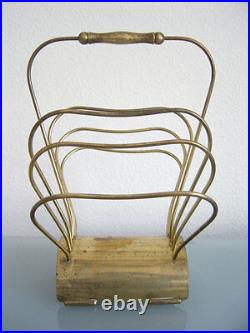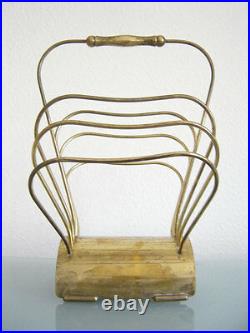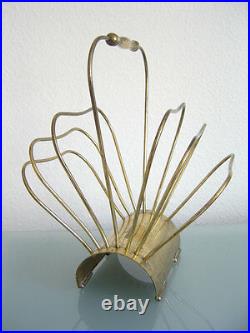








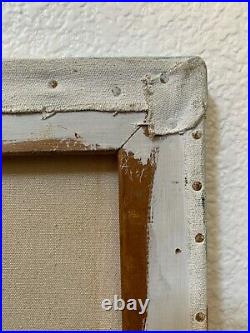

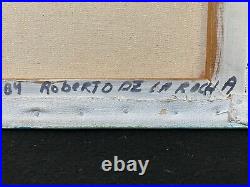


This is a Very RARE and Important Antique Mid Century Modern Mexican Chicano Abstract Oil Painting on canvas, by Los Angeles Chicano legend and one of the founding members of the Los Angeles Chicano art collective Los Four (Los Cuatro), Roberto “Beto” De La Rocha (1937 -) De La Rocha was also influential in re-establishing the tradition Mexican celebration of the Day of the Dead in Los Angeles, along with Los Angeles artist Gronk. De La Rocha was an active participant in the inception of Chicano art in the United State, and with other founding members (Carlos Almaraz, Frank Romero, Gilbert Lujan, and Judithe Hernandez), brought this new art form to the international spotlight. Unfortunately, after a few years, De La Rocha had a mental breakdown and left Los Four, and subsequently lived like a hermit in his house for 20 years and destroyed ALL of his artworks with the help of his young son Zack De La Rocha, singer of Rage Against the Machine. Because of this event, original works by De La Rocha from his time in Los Four (early 1970’s) are incredibly rare, and if not literally impossible to obtain due to their widespread destruction. If you were to research artworks by this painter, you would only see one original painting (from 1994), which is after his 20 year seclusion. This is the only one known to exist in private hands. This painting was acquired from a small estate sale in East Los Angeles. This painting is a beautiful and mesmerizing abstract scene, reminiscent of Kandinsky and Calder. Approximately 14 x 16 inches. This work is in good condition, with some light edge wear from age. Writing on the verso reads: Orig. By Roberto De La Rocha. This was likely a gift to this person by the artist in the early 1970’s. This work would be happily exhibited and accepted into The Cheech Marin Center for Chicano Art, Culture & Industry in Riverside California. Please check my other listings for more wonderful and unique artworks! Roberto Isaac “Beto” de la Rocha (born November 26, 1937) is an American painter, graphic artist, and muralist. He was part of the Chicano art collective Los Four for a few years. De la Rocha was also influential in re-establishing the traditional Mexican celebration of the Day of the Dead in Los Angeles. He is the father of Rage Against the Machine vocalist and lyricist Zack de la Rocha. Not much is known about de la Rocha’s early life other than what he mentioned to friends. Some of the things he mentioned was that his parents were Mexican American of Spanish Sephardi Jewish converso origin. He also received a Master’s of Fine Arts from CSU Long Beach. Almaraz describes de la Rocha as a “wonderful artist” and a “very good printmaker”. De la Rocha was very respected for his printmaking. De la Rocha was also described as having a very good background in the arts. He taught art at both CSU Long Beach and CSU Northridge. In 1973, he was introduced to the other members of Los Four by Gilberto Lujan and they quickly chose to form a group of collective artists. As a part of the group he gained much success and made several murals and art installations throughout Los Angeles. One of his biggest accomplishments was bringing the Mexican tradition of The Day of the Dead to Los Angeles. De la Rocha along with another artist, Gronk, simply decided to celebrate the day by dressing up in traditional skeleton costumes and going up the Evergreen Cemetery. The tradition started off small and was described as “a few weird artists doing this weird thing” but quickly grew in size. Within a few years, Los Four barely had anything to do with it. Soon after gaining success with Los Four, de la Rocha had a sort of mid-life crisis and decided that he was going to quit everything relating to art. He quit the group and went into a 40 day fast that heavily affected his physical and mental health. He dropped from 145 to 78 pounds. This landed him in the psychiatric ward at the LA County Hospital. After emerging from that, he locked himself away in his father’s home and began destroying all of his art claiming that it had all been created as act from the devil. Out of the Dark : He destroyed his art and began a 20-year journey of solitude and soul-searching. But now Beto de la Rocha wants to create again. E l profesor leans on his cane–an old broomstick, actually–to receive the swarming well-wishers. They have come to a Highland Park bookstore to celebrate the re-emergence of Beto de la Rocha–a trailblazing artist who gave up a promis ing career in the mid-1970s to begin an excruci ating, 20-year work-in-progress: a retreat into his soul. Not long after his involvement in a landmark exhibition of Chicano art, Rocha (as he prefers to be known) destroyed every one of his paintings and spent years seeking solitude and answers in a darkened house and a dog-eared Bible. But on a recent Sunday at Arroyo Books, those who have gathered to view an exhibition he helped curate–historical photographs chronicling Los Angeles’ early Mexican-American community–are grateful for what they find: a happy, smiling, public Rocha. A Rocha who has resumed his art. “I’m not going back into isolation, ” he tells an admirer who greets him with a hug. Twenty years ago, Rocha defected from the Chicano art scene, broke and disenchanted by the glamour and attention that a record-breaking 1974 exhibition at the Los Angeles County Museum of Art had brought him and members of Los Four–artists whose work had finally found mainstream acceptance. Fortune, says Rocha, failed to follow the fame his work had garnered. He divorced his wife and gave up a job as a fine-arts instructor at East Los Angeles Community College. He moved into his father’s Lincoln Heights home, closed the drapes, placed heavy locks on the doors and lived in seclusion, venturing outdoors only for groceries or to take odd jobs, mostly in carpentry. He read the Bible all day–every day–highlighting Scriptures, folding the corners of pages, memorizing verses. He took to heart the commandment not to make graven images and destroyed his artwork–considered by many, including his peers, as the best Chicano art of its time. He ignored all pleas from friends, mostly artists who worried about his welfare. They heard about his 40-day fast, his body withering away from 145 pounds to 78. Eventually, they stopped calling, stopped dropping by. And Rocha, who had come to regard all artists as “wicked and decadent, ” had himself been labeled by friends as the lost one. At his home, a small one-bedroom apartment he pays for with his monthly disability check, Rocha, 57, explains why he left. With the museum thing, I expected the whole world to open up to me. (But) nothing happened, he says, recalling that time as a young, hot artist toasted at parties and lauded for his talent. I didn’t know how to wait for success, how to be patient. He began to question his life–and future–as an artist and his role in el movimiento of the 1970s. Being Chicano was new to us. We never heard that term, ” he says, adding that it was a struggle for him to deal with his own identity “and an aesthetic criteria. So he quit painting because his soul demanded it, he says. I had to come to grips with who I was. ” He needed “a method to my life. ” He turned to religion “because I wanted to be civilized. Back then I was hateful, not kind. I was just nasty. ” And God, he says, provided “the law, the rules, the commandments that he followed. His only son, Zack, then a young boy, unknowingly also helped his father find answers during that turbulent time. They shared an incident neither will ever forget. Zack asked me if he could have a landscape drawing of mine. He was holding the drawing in front of me:’Daddy, can I have that? I said,’Hey, that’s mine,’ Rocha recalls, pausing to fight back his tears. He grips his cane. Here was a very tender young boy asking for this thing–a piece of flat canvas with paint, an object, a nothing–and I denied it to my son, a human. How could I have been so possessive? His voice cracks with emotion. As you can see, it is painful for me now. Later that night, Zack and his father ripped artwork off the walls, pulled it out of closets, from under the bed and behind doors. Beto plunged scissors into gorgeous landscapes, intricate woodblock prints and abstracts–many that had hung at the county museum–shredding everything he had ever created. Then, in a trash can, he burned the tattered scraps, splintered frames, paintbrushes and easels. “That was my moment, ” he says. That’s when I told myself I no longer want to be an artist. Zack de la Rocha, now 25 and a member of the rock band Rage Against the Machine, painfully remembers that time. I remember that incident having an impact on me because I was very fond of my father’s work. I loved his colors, the imagery. I found what he did fascinating. My dad was engaged in artwork that was political in nature, it was part of the Chicano movement, part of history, Zack says. He was struggling to come to terms with his art and with what it meant to him. He was struggling with his own identity, his own persona and his own role as a Chicano. He was at a point of conflict. To see him struggle was a struggle for me. Rocha says he destroyed his work for religious reasons, taking to heart one of God’s commandments that says,’Thou shalt not make unto thee any graven image. And he didn’t want to have anything to do with artists. So, metaphorically, I had made my home my cave. I became a troglodyte. Two years ago, Rocha was forced to face the outside world after his father died and he was evicted from the Lincoln Heights home. He resisted when officers came knocking on his front door to evict him. They couldn’t open the door. I had a good lock on it. They were making all this noise, he says. As they were getting closer to opening the door, I ducked into a closet. They didn’t arrest me, but they got me out. He found an apartment in Highland Park and began visiting Arroyo Books. He later joined a writers workshop that meets there, and began reading books besides the Bible. “I picked up a brush again, ” Rocha says of last summer’s job, which was followed in the fall with a reunion exhibition of Los Four at the Robert Berman Gallery in Santa Monica. He realizes that he may have taken the Bible too literally and been mistaken in believing that my making art was criminal. Besides, he says getting back to painting–although important–is not as worthwhile as his present passions: writing and the photo exhibition “Reconocimiento del Pueblo Olvidado, ” or Recognition of a Forgotten People. He asked several Mexican American families to contribute snapshots, all bound by rich, cultural histories. Set to close March 4, the exhibition includes more than 100 photographs–vintage and recent–that cover Arroyo Books’ walls from ceiling to floor, by doorways, on a stage, between bookshelves, behind counters. He hopes to take the concept to other Latino communities. At the bookstore party, many contributors to the exhibit–also curated by Oscar Castillo and Juan Aguilar–hover near Rocha, a tall, thin man with dark wavy hair and piercing brown eyes. They are careful not to bump his walking stick that helps his wobbly legs, the result of an ailment that struck in 1977 and impaired his equilibrium. He takes baby steps toward a group waiting to shake his hand and chat. A few artists and guests familiar with his artwork–described by admirers as technically superb, delicate, colorful portraits of the barrio–hang on his every word. “These are the forgotten people, ” Rocha says, standing before a wall covered with photos that have brought families–and the community–closer and recognized the role their ancestors have played in Los Angeles. “I see the exhibit as a tremendous opportunity to show a facet of the Mexican culture that does not exist anymore, ” says Joe Vera, 53, owner of a graphics firm who provided photographs of the Mexican Players of Padua Hills, a dance troupe directed by his father, Manuel. For 41 years, the Padua Hills group performed in a theater located in a remote area along the foothills of Mount Baldy. Carol Jacques, a Los Angeles County Probation Department manager, contributed nearly a dozen photographs, several of her grandparents who immigrated to Los Angeles from Mexico in 1907, settled in the lush hills of Palo Verde–where Dodger Stadium now sits–and operated a horse-and-buggy operation along Olvera Street. “This is history not found in history books, ” Jacques says of the exhibition. “And this man, ” she says, standing next to Rocha, is a legend. Linda Vallejo, owner of Galeria Las Americas and a friend of Rocha’s since 1975, is pleased that he is painting again. He went into a very, very dark place 20 years ago. I wouldn’t want to go there because most people don’t come out, says Vallejo, who has two of Rocha’s drawings from the’70s and two recently completed paintings in her gallery. Beto’s descent and ascent has the material with which great work can emerge. Romero, the former Los Four member, says Rocha was an artist’s artist. Somebody your peers look up to and admire. It was wonderful to watch his hands work, he was graceful and fluid. His hands were a great gift. Romero says he always wondered how Rocha would survive not painting, because we were born to paint. If you deny your own destiny, you get into trouble. ” Now, Romero says, the challenge for Rocha will be “to stick it out. Has learned anything in his 20 years of solitude, it’s endurance, he says. In many ways the exhibit epitomizes his life, he says. “This exhibit is about explorers and their discoveries, ” he says, pausing for several seconds. He looks up, his eyes teary, his voice cracking: Like life, it is about sacrifice and survival. This item is in the category “Art\Paintings”. The seller is “willsusa_utzeqm” and is located in this country: US. This item can be shipped to United States, Canada.
- Size: 14 x 16 in
- Region of Origin: California, USA
- Artist: Roberto De La Rocha
- Production Technique: Oil Painting
- Framing: Unframed
- Country/Region of Manufacture: United States
- Style: Muralismo, Muralism, Chicano, Abstract, Mexican
- Material: Oil, Canvas
- Type: Painting
- Subject: Abstract, Muralismo, Muralism, Mexican, Chicano
- Culture: Chicano
- Signed: Yes
- Signed By: Roberto De La Rocha
- Original/Licensed Reproduction: Original


